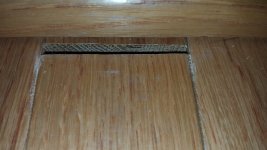GoingMyWay
Member
- Joined
- Oct 11, 2017
- Messages
- 3,782
There has been this gap in the hardwood flooring almost since the day I moved into the house, almost 10 years ago. I bought the house brand new from the builder so during one of our inspections I had them fix the gap. There used to be a very small piece of flooring that was under the quarter round moulding. They fixed it by adding a longer piece of flooring and I think they glued or nailed it in place. It was ok for a while, but I guess the little filler piece of flooring moved and now I get to look at this gap everyday.
[attachimg=1]
This bothers me as much, if not more than the cracked caulking on the stairway trim.
I was thinking of using Titebond III to glue to end grain together. Maybe shoot a couple 23 gauge nails through the face (ideally under the quarter round) to tack the piece in place while the glue dries. Is this a bad idea? Would it it be better to not glue the joint and just shoot either 18 or 23 gauge nails through the face of the small piece of flooring?
I didn't want to pull the quarter round trim up before I was actually ready to make the fix since I'm afraid my little puppy might want to start exploring and chewing on the newly exposed area.
[attachimg=1]
This bothers me as much, if not more than the cracked caulking on the stairway trim.
I was thinking of using Titebond III to glue to end grain together. Maybe shoot a couple 23 gauge nails through the face (ideally under the quarter round) to tack the piece in place while the glue dries. Is this a bad idea? Would it it be better to not glue the joint and just shoot either 18 or 23 gauge nails through the face of the small piece of flooring?
I didn't want to pull the quarter round trim up before I was actually ready to make the fix since I'm afraid my little puppy might want to start exploring and chewing on the newly exposed area.

